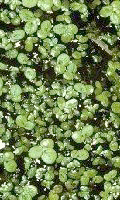| DESCRIPTION: A diminutive floating aquatic perennial, often forming a solid cover on the surface. USE: It is grown as feed in aquatic rice-based ecosystems in Cambodia and China. Their high fat and protein content makes them a source of food for animals and poultry. It has potential in wastewater treatment, absorbing excess nutrients from surface waters, including phosphorus and ammonias, reducing suspended solids, and reducing biochemical oxygen demand. GROWING PERIOD: Perennial or annual. COMMON NAMES: Lesser duckweed, Common duckweed, Duck's meat FURTHER INF: More cold tolerant than other aquatic vascular plants, and can sustain temperatures as low as 7ºC for normal, practical growth. Under freezing conditions, it will lay dormant on the pond bottom until warmer conditions return. A full, thick mat of duckweed may have a temperature of about 10ºC above ambient air conditions due to radiation. Can recover from winter temperatures down to -40°C. Plants may over winter as turions, or as seeds, sinking and resting at the bottom of the pond until they germinate. Spreads rapidly across quiet bodies of water rich in nutrients, growing best in water with high levels of nitrogen and phosphate, but will also grow in eutrophic water. Iron is often limiting. Wind and wave action can impede duckweed growth and stabilization by disrupting their ability to attach themselves to each other and form their characteristic homogenous colonial populations. Optimal conditions for growth are quiet streams and ponds. |
